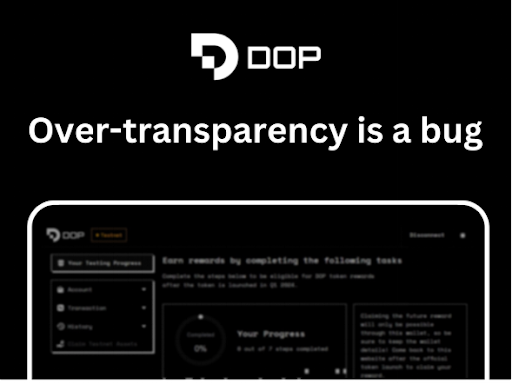
Full transparency, coupled with decentralization, are the fundamentals of blockchain. Because blockchain technology is inherently transparent, all transactions, including the wallet addresses and the amounts transferred, are visible to anyone on the network. While many glorify this inherent feature, the industry has growing concerns about the potential risks associated. Could blockchain stay decentralized and safe while giving users ownership over their data?
The soon-to-be-launched Data Ownership Protocol (DOP) claims they found a solution to this burning question. DOP's recently released Sepolia testnet aims to prove web3 is ready for data ownership and, hence, the mainstream.
What exactly is DOP advocating for, and how will their solution make web3 a better place for individual and institutional users?
Issues with on-chain transparency
DOP follows a simple maxim: "Over-transparency on the blockchain is not a feature, it's a bug." In traditional finance, users' most sensitive financial data, such as account balances and incoming and outgoing transactions, are encrypted and invisible to non-involved parties. On blockchain, this information flows freely. According to DOP, this impacts both individual users and businesses.
It makes sense for web3 users to want control over who can access their transaction details. Currently, curious eyes can trace assets, track trades, and map out people's and companies' digital wealth. This level of transparency means your financial moves are on display for all to see. Total transparency allows unlimited snooping, which may not always align with users' desires for the discretion of their digital assets.
At the same time, web3 wallets have become a 'social media' profile, where assets held (especially NFTs) play a crucial cultural role in building one's identity. Many are proud of their holdings, a testament to the projects they support and the communities they belong to. That's why, according to DOP, the holy grail lies between privacy and transparency.
Hiding from the curious eyes while being able to showcase assets one is proud of is only one desire blocked by total transparency. With the rise of blockchain analytics tools such as Etherscan or marketing analytics solutions, on-chain data transparency opens doors for data extraction and profiling. What is most concerning is that web3 profiling might not only be used by marketers and salespeople but may also lead to targeted phishing attacks. And as it often happens, the ones most susceptible to those are web3 newbies, who, if this happens, will quickly become discouraged from further exploring this new technology.
DOP also sees business arguments against total on-chain transparency. It argues that complete transparency becomes a burning issue as more businesses incorporate crypto payments to transact with clients, partners, and customers or pay employees in crypto. Not being able to undisclose employees' compensations or how much certain clients are being charged is why many businesses decide against incorporating crypto payments into their financial operations.
Those aware of the transparency and security issues on-chain often resort to having many wallets and changing wallets regularly to protect their data. Yet this solution requires a lot of planning and self-discipline.
For those who want to participate in web3, it is either agreeing on transparency or coming up with complicated data security tactics. DOP argues there is a third way one wallet with selective data transparency.
Transparency and regulatory compliance
In opposition to privacy activists, advocates of total on-chain transparency quote the basics of blockchain and often address regulatory compliance issues. If all transactions are private, understanding where certain funds come from becomes difficult, which, to many, is a significant issue.
Nevertheless, the solution might again lie in the middle. Vitalik Buterin addressed this dilemma in his recent paper on the blockchain equilibrium between privacy and regulatory compliance. Buterin argued: "In many cases, privacy and regulatory compliance are perceived as incompatible; this does not necessarily have to be the case if the privacy-enhancing protocol enables its users to prove certain properties regarding the origin of the funds."
DOP follows Buterin's philosophy, proving that on-chain data ownership is not about total transparency or complete privacy but a solution allowing to disclose holdings when users want or need it to verify their information.
DOP's Novel Selective Transparency Solution
With the launch of their testnet, which was completed by over 7,5k users in the first twelve hours since launch, DOP is proving the secure and easy-to-use solution to the blockchain transparency bug is here. The vast reception proves that users eagerly await solutions allowing them to choose what to disclose and what to keep private.
The testnet, which allows people to encrypt assets, send encrypted tokens, and decrypt certain holdings, shows only a part of DOP's total possibilities. DOP proves that selective data transparency is possible and sets the scene for the main net big reveal in Q1 2024.
DOP proves its friendly UX will soon allow crypto newbies and natives to choose precisely what assets are visible to everyone, which are kept private, and which assets are encrypted and shared only with those named by the wallet holder.
It looks like 2024 will be the year in which the blockchain buzzword "total transparency" will be replaced by "data ownership" and "selective transparency."









